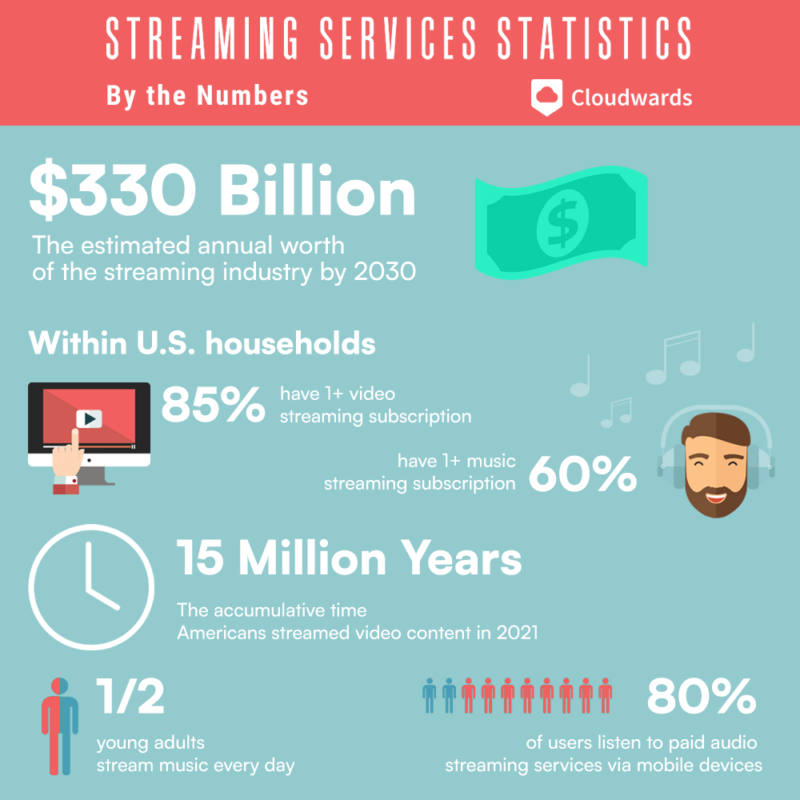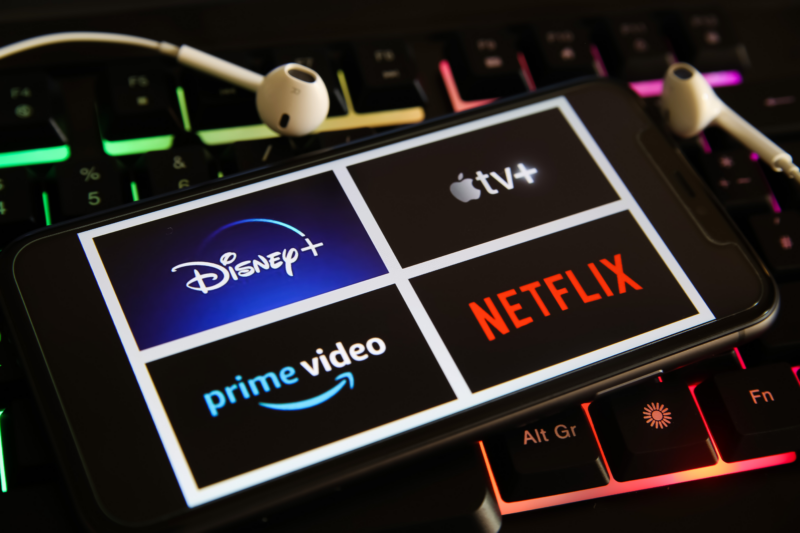The ways we watch shows and movies — and how we listen to music — have changed dramatically over the last decade. Gone are the days of visiting your local video rental store or waiting a whole week to catch the next episode of your favorite show. On-demand subscription services have taken hold, so let’s look at the top streaming services statistics for 2022.
Streaming services come in all shapes and sizes, with some providing only on-demand content and others adding live TV and local channels. Then there’s the music streaming scene, with both free and paid options letting you listen to your favorite songs on pretty much any device.
In this article, we’ll go over different streaming statistics and facts to show how the online streaming world has reshaped the video and music industry.

37 Streaming Services Statistics: Video & Music in 2022
Video and music streaming is a global industry that just keeps growing. If you’re wondering how much it has grown and which services are the most popular, among other interesting facts, these streaming statistics will cover everything from video streaming market to music streaming statistics — though we won’t dive into the live streaming industry.
Statistics on the Most Popular Streaming Services and Market Share
Below are streaming statistics focused on Netflix, Amazon Prime Video, Disney Plus, Hulu and Max. We include other services in our table of streaming platforms and prices, but most of the detailed statistics will be on the top five providers.

1. Streaming Services by Subscribers: Full List
The list below shows the top five streaming services by subscribers. While it doesn’t fully reflect the streaming services’ market share by percentage, it is indicative of the popularity of the services listed.
- Netflix — 222 million subscribers
- Amazon Prime Video — 200 million subscribers
- Disney Plus — 129.8 million subscribers
- HBO Max — 73.8 million subscribers
- Hulu — 45 million subscribers
2. Full List of All Streaming Services and Prices
Below is our list of all streaming services and prices that we could scrounge up in our research. These prices are for the U.S. market and may be subject to change.
| Streaming service | Monthly cost (ad-supported) | Monthly cost (ad-free) | Simultaneous devices | Free trial |
|---|---|---|---|---|
| Netflix | $7 | $15 | 1 to 4 | None |
| Amazon Prime | $9 | $12 | 3 | 30 days |
| Disney+ | $8 | $14 | 4 | None |
| Paramount+ | $6 | N/A | 3 | 7 days |
| Peacock | $6 | $12 | 3 | None |
| Apple TV+ | N/A | $7 | 6 | 7 days |
| Hulu | $8 | $18 | 2 to 5 | 30 days |
| Max | $10 | $16 | 2 to 4 | None |
3. How Many Subscribers Does Netflix Have?
Netflix had 222 million subscribers by the end of 2021, an increase of 18 million over the year. However, that was significantly less than the previous year, with Netflix recording an increase of 37 million paid subscriptions in 2020.
Netflix believes the annual growth rate slowed due to production delays caused by COVID-19. Still, its total streaming revenue was more than $7 billion at the end of 2021, giving it a 16% revenue increase year by year.
Netflix is available in more than 190 countries. The number of subscribers in each region varies widely due to infrastructure and population numbers as a whole. As of Q1 2022, Netflix had 74.58 million subscribers in the U.S. and Canada, followed closely by Europe, the Middle East and Africa with 73.73 million.
The Latin America and Asia-Pacific regions had roughly the same number of subscribers collectively, with 39.61 and 33.72 million, respectively.5, 6, 16
4. How Many Shows and Movies Does Netflix US Have?
As of May 2021, Netflix U.S. had more than 3,700 movies and 3,500 TV series seasons in its library. Netflix spent $12.5 billion on content in 2020, which rose to $17.4 billion in 2021.
Figures taken in December 2021 show that almost half (44%) of the U.S. Netflix library consists of Netflix originals. Other countries followed close on its heels, with Australia at 42%, Canada at 40% and the U.K. at 38%.9, 18

5. What Are Some of the Most-Watched Netflix Shows?
Netflix has aired many successful shows and movies, which have garnered high viewing numbers in a short space of time. Some are viral hits from the get-go, with Squid Game generating 1.65 billion viewing hours in its first four weeks and Tiger King being viewed in more than 60 million households in the first four weeks.
La Casa de Papel (Money Heist) accumulated more than 6 billion viewing hours over the lifetime of the show. Other popular shows include The Witcher and You, which both amassed more than 400 million viewing hours. 5, 20
6. How Many Subscribers Does Amazon Prime Have?
Amazon Prime had more than 200 million Prime members in 2020, and the number is still rising. Content-wise, Amazon has thousands of titles in its library, and many of those titles are Prime originals.
Two of their most successful shows are Reacher and The Marvelous Mrs. Maisel. Reacher racked up more than 1.5 billion viewing minutes (25 million hours) within the first week and the season four premiere of The Marvelous Mrs. Maisel achieved 499 million viewing minutes (more than 8 million hours) in the same amount of time.7, 22
7. How Many Subscribers Does Disney Plus Have?
Disney Plus added another 11.8 million new subscribers by the end 2021, giving it a massive total of 129.8 million global subscribers in 2021. That includes the 45.9 million subscribers of India’s Disney+ Hotstar service.
Disney+ now has more than 500 movies and 15,000 episodes in its library. There are also 80 Disney Plus originals available.15, 23
8. How Many Subscribers Does Hulu Have?
As reported in 2022, Hulu has more than 45 million paid subscribers in the U.S. Its content library contains more than 70,000 movies and TV episodes. Subscribers with the live TV package can enjoy more than 80 live channels.21

9. How Many Subscribers Does Max Have?
At the end of 2021, HBO and Max had a combined subscriber count of 73.8 million around the globe. Max has more than 13,000 hours of entertainment, including TV shows, movies and Max originals.24, 25
10. What Is a Streaming Service’s Average Budget for a TV Series in the US?
The average budget for creating a streaming TV series in the U.S. has increased by 16.5% each year, reaching $59.6 million in 2020, but the average doesn’t tell the whole story.
Disney’s budgets for Wandavision and The Falcon and the Winter Soldier were much bigger than the mean, with each episode having a budget of $25 million. Disney’s total estimated content spend for 2021 was a little over $30 billion. That’s almost two times Netflix’s $17 billion budget for 2021.9, 17
General Video Streaming Statistics
Global and U.S. video streaming is continuing to grow, especially after the start of the COVID-19 pandemic. See the video streaming statistics below for data on how the market is evolving.

11. How Much Is the Global Video Streaming Market Worth?
The global video streaming industry was valued at a whopping $50.11 billion in 2020 and rose to $60.1 billion by 2021. The market is expected to grow annually by 21% between 2021 and 2028, giving it an estimated total value of $330 billion by 2030.1, 32
12. Has Streaming Activity Increased Around the World Since COVID-19?
Streaming increased by 21% over Q3 2020. Looking at individual regions, Africa had the greatest surge in streaming activity, increasing 273%. Oceania had the second highest increase at 80%. North America’s streaming market has steadily increased by 2% over the past few years. Netflix saw a huge spike in subscriptions in Q1 2020 due to COVID-19 restrictions.2, 9
13. How Much Can the US Streaming Audience Watch?
During lockdown in March 2020, the U.S. streaming audience watched a massive 160 billion minutes of content — the equivalent of 304,414 years of straight watching. If you were to put that in historical context, it was when humans evolved.
Still, that number was surpassed in the last week of December 2021, with the U.S. audience streaming a total of 183 billion minutes, or 348,173 years straight — an extra 44 thousand years.
Every week in February 2021, Americans streamed 143.2 billion minutes of video content. That increased to 169.4 billion in February 2022, showing that this figure is likely to continue increasing. Overall, Americans streamed almost 15 million years’ worth of video content in 2021.8, 10
14. What Percentage of US Households Have a Paid TV Subscription?
In 2021, it was reported that 67% of U.S. households had a paid TV subscription, proving that while cord-cutting is popular, it has not completely taken over the industry. That said, with many streaming services offering live TV packages, that figure could change.4
15. What Percentage of US Households Have Subscriptions to Streaming Services?
Around 85% of U.S. households now have at least one subscription to a video streaming service, such as Netflix, Hulu, Amazon Prime Video orMax. U.S. users have an average of four streaming service subscriptions, according to the Deloitte Digital Media Trends Study. Another study found that 7% of Americans have six or more streaming subscriptions.3, 4, 10

16. How Much Are People Paying for Streaming Services?
A full 15% of people said they spend $50 or more on video streaming subscriptions per month, but the majority of people spend between $20 and $29.99. Those aged 35 to 49 spend the most on streaming subscriptions, with 24% paying for more than five.
A whopping 93% of Americans said they plan on increasing their streaming options or at least making a change to their existing streaming plan.10
17. What Are the Most Attractive Features of a Video Streaming Service?
From a 2021 survey of people aged 18 and over, 35% said the top feature that made them want to watch subscription video on demand (SVOD) was having access to the shows they want. Coming in at a close second, 34% said it was being able to binge-watch content.9
18. What Do Consumers Think of Streaming Service Bundles?
While cord-cutters initially turned to streaming services to circumvent package deals, many consumers now want some sort of streaming service bundle. In one survey, 46% of people said the streaming service choice was becoming overwhelming and 64% said they would prefer a bundle that allowed them to choose which streaming services they wanted.10
19. What Is the Main Reason People Might Cancel a Paid Streaming Subscription?
Though there can be many reasons for subscription cancellations, 49% of people said the most likely reason would be a price increase, and 31% said it would be specific content being removed.
However, a portion of subscribers plan to cancel after watching a specific show. For instance, Apple TV+ had success with Ted Lasso in the last two quarters of 2021, but 19% of users planned to cancel their subscription in Q1 2022 after they finished watching it.
It’s a similar story with Dune on Max in Q4 2021 — 7% of new subscribers planned to cancel after they’d watched the sci-fi blockbuster.3, 4
20. What Device Do People Use Most for Streaming?
In late 2021, more than 81% of U.S. households had at least one TV-connected device, an increase from 72% in 2019.
In Q3 2021, 73% of global viewing time was on big screen TVs. That includes streaming directly on a smart TV, or using streaming devices or game consoles connected to a TV. Asia was the only region where big screen TVs didn’t dominate, with desktops winning the majority at 49%.2, 10
21. How Do FAST Services Shape the Streaming Landscape?
FAST — short for “free, ad-supported streaming TV” — has seen a large increase in subscribers. The percentage of American households using FAST services more than doubled from 8% in 2020 to 18% in 2021. These services include Pluto TV, Tubi, Peacock, The Roku Channel and more.3
22. How Many People Use an Ad-Supported Streaming Service?
Ad-supported streaming subscription tiers are usually offered as a cheaper — or free — way to stream. In the U.S., 55% of people use an ad-supported video streaming service.
Consumers have mixed feelings on the subject, with 28% saying they want an ad-free streaming experience and 16% claiming they would leave if advertisements were added to the service. On the other hand, 53% of U.S. consumers said they would be happy to watch commercials between shows if the cost of streaming services was lowered.4, 19
23. How Many Households Use Streaming Services That Include Live TV?
Although video streaming platforms used to provide only on-demand content, many now provide live TV and cable channels too. This type of service is growing in popularity, with 12.5% of households now using a streaming service with live TV. YouTube TV has the highest percentage of household subscriptions, having grown by 160% since 2020.10
24. Why Would People Subscribe to a Brand New Streaming Service?
Most users enjoy discounts and freebies, and the streaming world is no exception. As many as 46% of people said they would consider signing up for a new service if the price was low enough, and 28% said they would be tempted if it offered a free trial or discounted price.
In terms of content offered, 33% said they would sign up if the service had content they want that’s not available elsewhere, and 24% said they would if it had previously released content that they can’t find anywhere else. Plus, 32% would subscribe for new original shows or movies produced by the streaming service.4
25. What Are the Main Reasons for Signing Up for a Free Trial?
A 2021 survey found that 15% of young people ages 18 to 29 said they used a free trial to sample the service before committing to a paid subscription, which was almost double the rate found in older age brackets.
However, 8% of the same age group said they used free trials to binge-watch a single series or a movie. Still, around half of each age group surveyed said they had not used a free trial. Only two out of five people who use a free trial end up paying for a subscription once it ends.9
26. How Satisfied Are Video Streaming Subscribers?
A recent survey found that 72% of Americans say they love their streaming service user experience. Close to 80% of Netflix subscribers said they were satisfied with the service.9, 10
American Satisfaction of Streaming Service
Music Usage and Music Streaming Statistics 2022
Music streaming services, such as Spotify, Amazon Music Unlimited and Apple Music are increasingly popular. As the streaming statistics show below, the industry is constantly growing, but let’s see what other interesting statistics and facts we can unveil.

27. How Much Is the Global Music Streaming Market Worth?
The value of the worldwide music streaming market was $29.45 billion in 2021 and $34.53 billion in 2022. It’s expected to increase by 14.7% between 2022 and 2030, reaching a total of $103.07 billion by 2030. The U.S. music streaming market alone was valued at $9.2 billion and is expected to increase by 13.3% for the same period.11
28. Do Music Streaming Services Make a Significant Contribution Toward the Total Music Industry Revenue?
A report conducted in 2019 showed that music streaming revenue, including both ad-supported services and premium paid services, made up about 80% of the revenue of the total music industry.4
29. How Many Paid Music Streaming Subscriptions Do People Have on Average?
According to a 2021 report, 60% of people in the U.S. subscribe to at least one paid music streaming service, with the average number of subscriptions per person being two.
Younger people are more likely to use a subscription audio streaming service, with around 60% of those ages 16 to 34 saying they use such a service. The figure decreases among older age groups.4, 28
30. What Are the Top Reasons for Using a Paid Music Streaming Service?
A 2021 survey revealed the top reason users paid for a music streaming service was to stop advertisements interrupting the music stream. Other top reasons: listening to what they want when they want it, having access to millions of songs and having access to their own playlists.28

31. Why Would Users Cancel a Music Streaming Subscription?
Just like with video streaming, there are various reasons why someone might cancel. A study showed that 37% of users would cancel a paid music service if the price increased and 29% would cancel if certain content was removed.4
32. How Many People Use an Ad-Supported Music Streaming Service?
In 2021, 62% of U.S. consumers used an advertising-supported music streaming service, such as YouTube, ad-supported Spotify and TikTok.
In 2020, the ad-supported music streaming market saw 18% growth with $1.2 billion of revenue. The following year saw an even bigger hike, with ad-supported music streaming revenue growing by 47% to $1.8 billion.4, 13
33. How Often Do People Stream Music?
It has been reported that around half of young adults between the ages of 18 and 29 stream music every day. The year 2019 was a milestone for the music streaming industry, with on-demand music streams in the U.S. passing the one trillion mark. The end total for the entire year was a whopping 1.15 trillion.4, 12
34. Did COVID-19 Impact Audio Streaming?
The COVID-19 pandemic increased audio streaming use, with on-demand audio streaming increasing 17% in the U.S. by the end of 2020.29
35. Which Devices Do Consumers Use Most for Streaming Music?
Some 80% of users listen to paid audio streaming services via mobile devices. Smart TVs and smart speakers, such as Amazon Alexa and Google Home, are used by 41% of paid music streamers. In-car entertainment accounts for only 24% of users.
Computers still make up a good portion of usage at 39%, and with many popular music streaming services now available on browsers, this figure could increase. Using a music streaming service through a web browser takes away the need for a dedicated app.10, 11

36. How Many Users Does Spotify Have?
Spotify’s 2021 global financial results revealed an 18% year-by-year increase of monthly active users, totaling 406 million users by the end of 2021. For the same period, its premium subscriptions grew by 16%, totaling 180 million.
Spotify currently has a total of 422 million users, with 183 million of those being paid subscribers, making it the top podcast and music streaming service right now.14, 31
37. How Many Subscribers Does YouTube Music Have?
In late 2021, Lyor Cohen, YouTube’s global head of music, announced that the YouTube has surpassed a milestone with more than 50 million subscribers. However, that’s a combined total of both YouTube Music and YouTube Premium subscribers, including trailers.30
Final Thoughts: Streaming Statistics
The online streaming world for both video and music content is growing fast. Not only are more and more people turning to such services for the pure ease of streaming what they want when they want, but we’re also seeing a spike in new streaming services.
On top of that, the type of content on offer has changed over time, with instant access to video-on-demand, live TV and music streams. While such services offer the freedom to watch or listen to content at your own pace and from anywhere you want, many consumers struggle with too many service choices.
Do you have a subscription to video content online? How many streaming music services do you subscribe to? What’s your favorite streaming platform and why? How do you choose between exclusive content? Let us know in the comment section and, as always, thanks for reading our article on audio and video streaming stats.
FAQ: 37 Facts on Streaming Services
-
The most used streaming platform in 2022 is Netflix, which has more than 220 million subscribers across the globe.
-
Although we may only think of the top streaming services, such as Netflix, Disney+, Amazon Prime Video and Hulu, there are actually more than 200 streaming services available around the world.
-
Yes, Netflix is the number one streaming service in the world, with more than 220 million subscribers.
Sources:
- Grand View Research – Video Streaming Market Size & Share Report, 2021-2028
- Conviva’s State of Streaming report for Q3 2021
- Kantar – Entertainment on demand panel
- Deloitte Digital Media Trends Study, 15th Edition (2021)
- Netflix Q4-2021 Shareholder Letter
- Netflix Q4-2020 Shareholder Letter
- Amazon 2020 Letter to Shareholders
- Nielsen Streaming Insights 2021
- VIP+ Variety Intelligence Platform – Dare to Stream report, fifth edition, August 2021
- Nielsen State of Play report Q1, 2022
- Grand View Research – Music Streaming Market Analysis Report 2022
- Nielsen Year-End Music Report U.S. 2019
- Recording Industry Association of America (RIAA) 2021 Year-End Music Industry Revenue Report
- Spotify Financial Results for Q4 2021
- CNBC Article
- Netflix Q1-2022 Shareholder Letter
- Variety.com – Netflix Content Budget 2021
- What’s on Netflix – Netflix Library By the Numbers 2021
- MarTech Series – New Survey Points to Streaming Subscription Fatigue Among US Consumers, Jan 2020
- The Verge – Netflix Says Tiger King is as Popular as Stranger Things
- Hulu Corporate Webpage
- Amazon 2022, First Quarter Results
- Disney Plus – “What Is Disney+?” webpage
- Variety – HBO and HBO Max article
- HBO Max help center – All About HBO Max – “What is HBO Max?”
- Digital Music News – Apple Hits an Impressive 745 Million Paying Subscribers 2021
- Digital Music News – Apple Music Boasts 60 Million Paying Subscribers 2019
- IFPI’s Engaging With Music Report 2021
- MRC Billboard Year-End 2020 U.S. Final Report
- YouTube Official Blog – 50 Million
- Spotify Newsroom Company Info
- BlueWeave Consulting: Video Streaming Market Report
The post 37 Streaming Services Statistics for 2024: Deep Dive Into Video & Music Streaming appeared first on Cloudwards.

